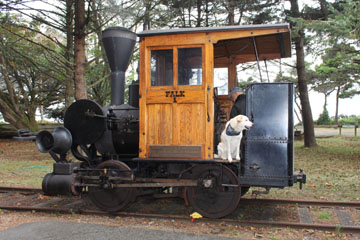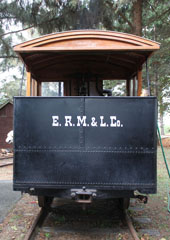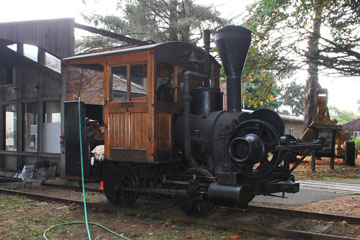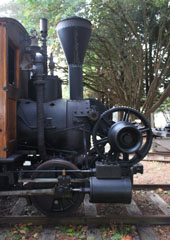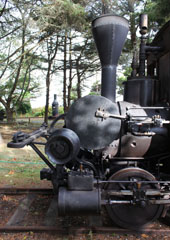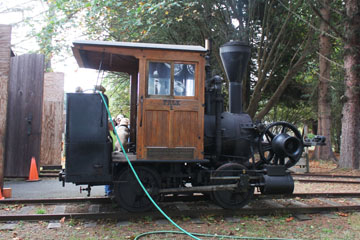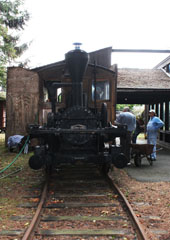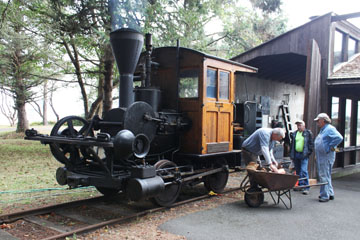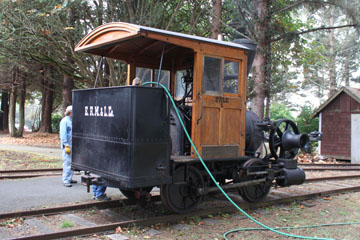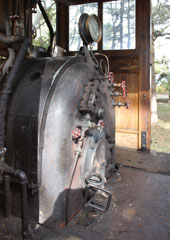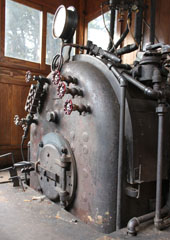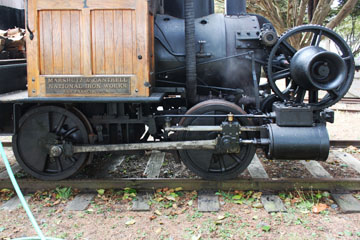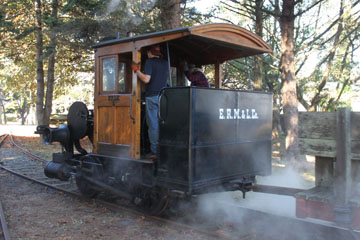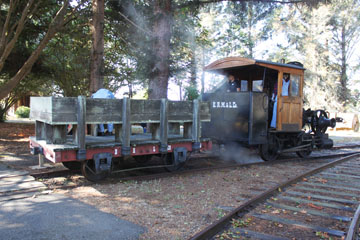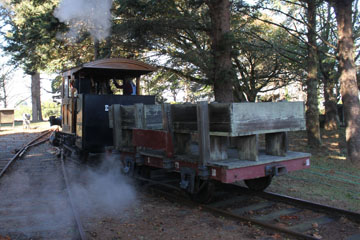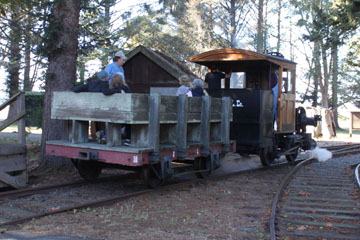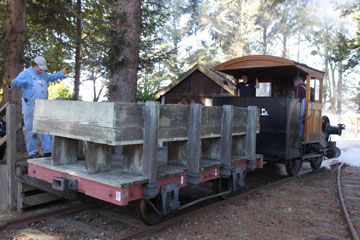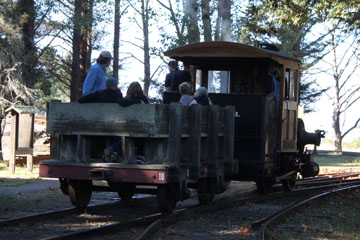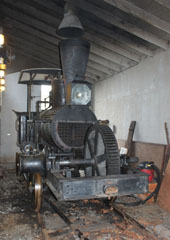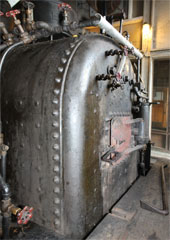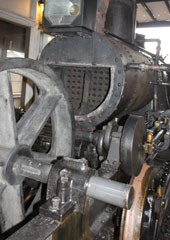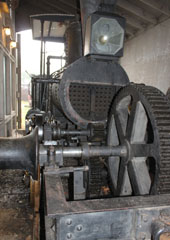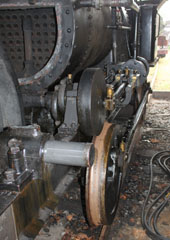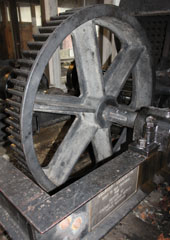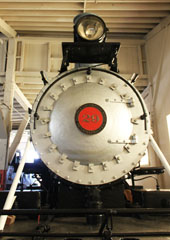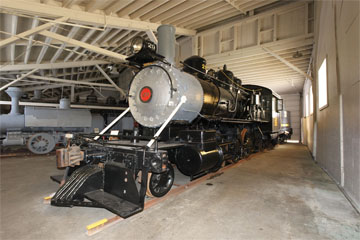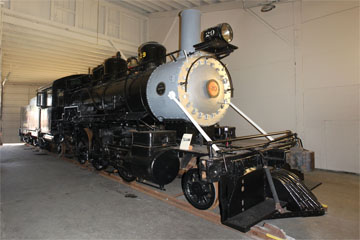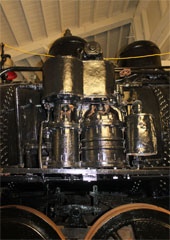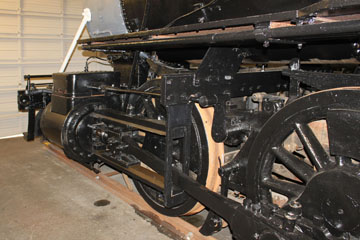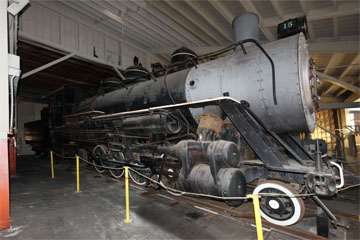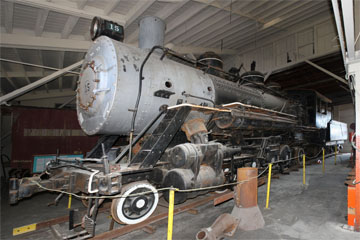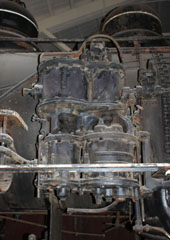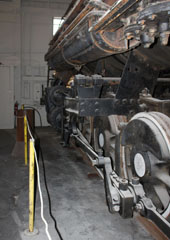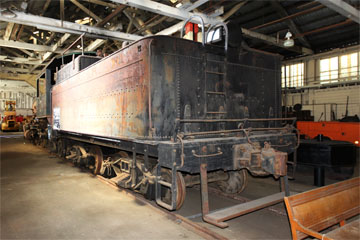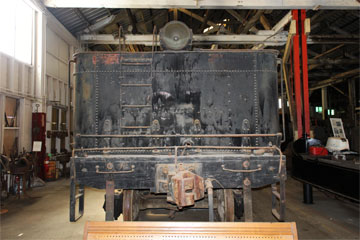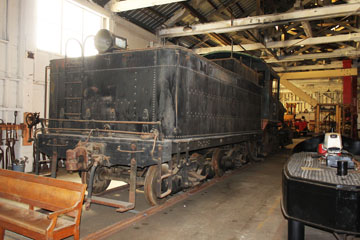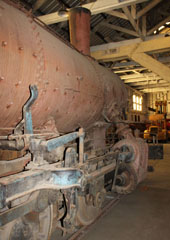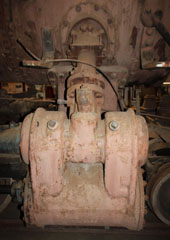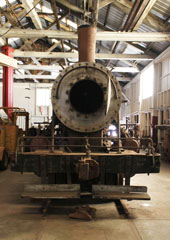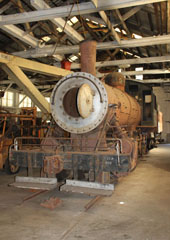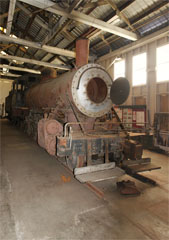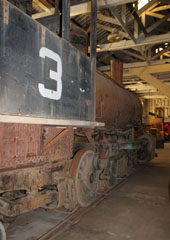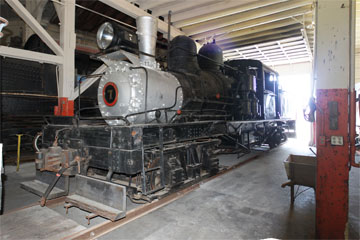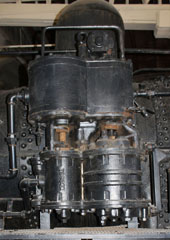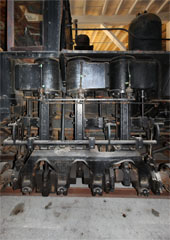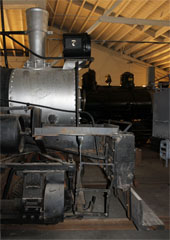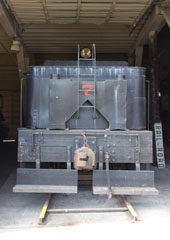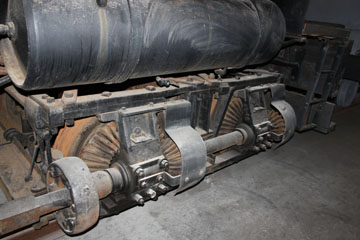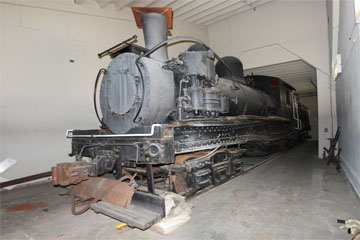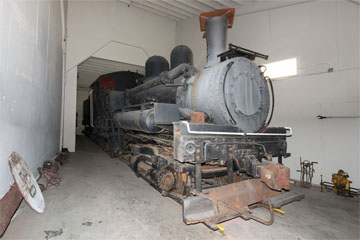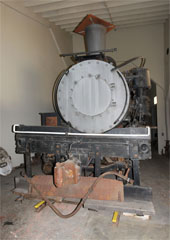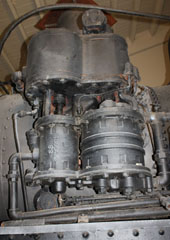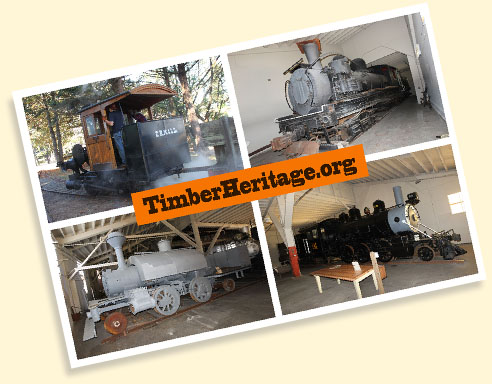

The Timber Heritage Association is a volunteer group based in Samoa, CA, whose purpose is to create awareness and appreciation for the fascinating history of timber, logging, and railroads in the settlement and growth of Humboldt County. When I visited, I was made very welcome, the President even very kindly unlocking the roundhouse and engine house out at Samoa so that I could take the photos shown later on this page.
A group of individuals interested in preserving timber industry history originally formed the Northern Counties Logging and Interpretive Association in 1977. Activities centred around a logging exhibit at Fort Humboldt State Historic Park in Eureka, CA, and the Association restored a steam donkey, Bear Harbor Lumber Co. #1 and Elk River Mill & Lumber Co. #1 to operating condition.
In the early 2000s, the Association acquired a lease on the railroad shop complex of the former Hammond Lumber Company at Samoa, CA. Within this complex is an original 1890s roundhouse, which housed the company’s locomotives.

I started my visit to the Association at Humboldt State Park, where Elk River Mill & Lumber Co. #1 aka “Falk” was being steamed up, with Lola the golden retriever in the cab.
This 24,000 lb wood burning 0-4-0T was built by Marshutz & Cantrell, San Francisco, CA, in 1884. It has 33” drivers and 9” x 12” cylinders. It is a variant of the “gypsy” type locomotive, which includes a capstan steam winch, designed for use on Northern California's logging railroads. Bought by Noah Falk, it was carried by ship from San Francisco to Arcata, CA.
#1 hauled logs at the Dolly Varden Mill in north Arcata until it was moved to Falk, CA, in 1885.
Used on the Elk River Mill & Lumber Co. Railroad, it was the
only locomotive there until 1903, when a larger locomotive, #2, arrived.
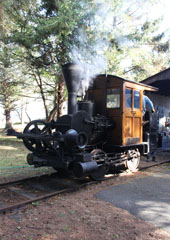
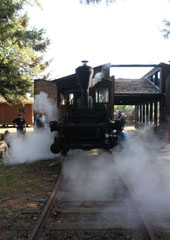
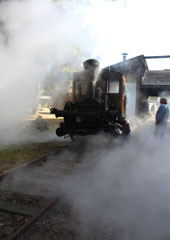
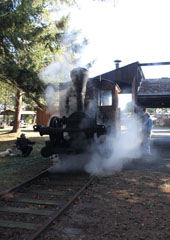
#1 was then relegated to switching duties. A
third locomotive was bought by the railroad in
1927 and "Falk" was retired. It was given to the
city of Eureka, CA, for a 1937 4th of July parade where it operated on street car tracks on 2nd Street.
The locomotive was restored by Association volunteer labour and State Parks funding in 1986, and is operated monthly by volunteers during the summer at the Park Logging Exhibit. It is owned by the City of Eureka on loan to California State Parks.

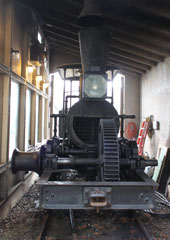
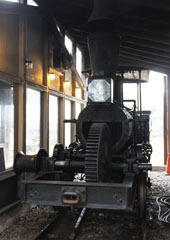
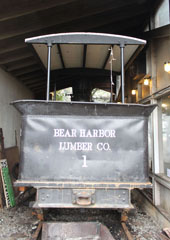
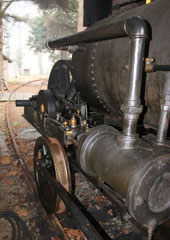
Bear Harbor Lumber Co. #1 is another "gypsy" locomotive. It was used to haul tanbark (used in tanning leather) to the wharf at Bear Harbor. After the company ceased operations in 1905, it went into storage until donated to the State of California. It was rebuilt by Northern Counties Logging Interpretive Association.
An 0-4-0 built by Marshutz & Kantrell, San Francisco, CA, in 1892, it weighs 24,100 lbs with 30" drivers and 8" x 12" cylinders. Operating at a boiler pressure of 50 psi, it delivered 1,080 lbs tractive effort.

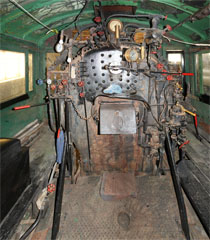
#29 weighs 120,000 lbs, 90,000 lbs on its 52”
drivers. Equipped with Stephenson valve gear, it has 18” x 24” cylinders. The grate is 17.4 sq ft and the firebox 127.7 sq ft. With a total heating surface of 1,765 sq ft and operating at a boiler pressure of 160 psi, it delivered 20,337 lbs tractive effort. The tender weighs 60,000 lbs fully loaded.
#29 was the last steam locomotive to operate on the PLC. Toward the end of its working life, it served as backup for larger steam locomotives and later three diesel locomotives added to the roster. It was re-tubed in 1960, retired in 1961 and stored in the engine house until donated to the Association in 1986

It has a 13' 10" driver wheelbase, 27' 10" engine wheelbase, Walschaert valve gear and 20½” x 28” cylinders.
The grate is 41.3 sq ft and the firebox 178 sq ft. Total heating
surface is 3,053 sq ft, including 553 sq ft superheating.
#15 is a 2-8-2 Mikado type locomotive, built by the Baldwin Locomotive Works in 1916.
The Mikado was a popular type in the US, its leading and trailing trucks making it highly manoeuvrable bi-directionally, suited to logging concerns.
Former Humbird Lumber Co., #4 and Mason County Logging Co., #12, this locomotive was bought by Hammond Lumber in 1941 and renumbered #15. It worked mostly hauling log trains from Crannell to Samoa, CA. After the company bought its first diesel, it was used only when the diesel was out of service.
Hammond became Georgia Pacific in 1956. Four years later, after the company closed down, #15 was donated to the city of Eureka, CA, for display at Sequoia Park. The city donated the locomotive to the Association in 1979.
#15 weighs 177,400 lbs, 138,300 lbs on its 48” drivers. Operating at
a boiler pressure of
160 psi, it delivered 33.340 lbs tractive effort.
The tender weighs 270,000 lbs with a
4,500 gallon water
and 8,000 gallon oil capacity.

An oil burner, #3 weighs 124,000 lbs, 96,500 lbs on its 44” drivers. It is equipped with Walschaert valve gear and has 17” x 14” cylinders. The engine wheelbase is 24’ 10” and the driver wheelbase 9’ 6”. The grate is 21 sq ft and the firebox 104 sq ft. With a total heating surface of 1,342 sq ft, including 292 sq ft superheating, it operated at a boiler pressure of 175 psi delivering 23,448 lbs tractive effort.
The tender weighs 75,700 lbs fully loaded and has a capacity of 1,500 gallons of oil and 3,500 gallons of water.
Humboldt Northern Railway #3 is a Prairie type (2-6-2) locomotive built by the Baldwin Locomotive Works in Philadelphia, PA, in 1922. It operated from Samoa to north of Fieldbrook , CA, for eleven years on the Humboldt Northern.
In 1927, after then owner Dolbeer & Carson Lumber Company’s timber had been logged out, the line was sold to the Little River Redwood Co., although Dolbeer & Carson continued to run
trains until 1930. Humboldt Northern’s locomotives were then transferred to the Dolbeer & Carson Lumber Co.
In 1950, Pacific Lumber Co., bought Dolbeer & Carson and closed the railroad three years later. #3 was sent to the scrapper Purdy Co., who sold it to the Stockton Terminal & Eastern Railroad where it served as backup to a diesel as well as running on excursions until 1955. It was then stored unserviceable until donated to the California State Railroad Museum in 1987.
At CSRM, it was partially dismantled and ultra-sound tested in readiness for restoration. When CSRM had to reduce the size of the collection in 2008, the museum donated #3 to THA.

Between 1970 and 1973, #7 was returned to service on Arcata & Mad River to haul tourist trains It was then retired again and returned to
the city, who leased it to THA to restore in
1986. The city sold the locomotive to THA in 2001 for $1.
Built as a wood burner, Northern Redwood converted #7 to an oil burner soon after
purchase. It weighs 100,000 lbs and has 32"
drivers and three 11" x 12" cylinders. Operating at a boiler pressure of 200 psi, it delivered 22,563 lbs tractive effort.
Two-truck Shay #7 was built in 1918 by Lima Locomotive works for the Lamson Logging Co., in Euphala, WA, as #1. It worked for Lamson until 1942, when it was bought by Arcata & Mad River Railroad and renumbered #7. It then worked between Korbel and Korblex, CA, and on the Northern Redwood Lumber Company.
In 1956 Simpson Redwood Company bought Northern Redwood and the Arcata & Mad River and abandoned the logging railroad out of Korbel. In 1957, #7 was donated to city of Arcata, CA, for display in a city park.

After logging trains were discontinued by Pickering Lumber, #33 was sold to the Tuolumne based tourist line, Westside & Cherry Valley Railway, in 1976.
When the line was closed down due to lack of trade, #33 was sold to THA in 1981.
#33 is a three-truck Shay built for Hammond Lumber by the Lima Locomotive Works in 1922
to haul logs over steep grades east of Cranell,
CA. It weighs 169,000 lbs, with 36" drivers and three 14½" x 15" cylinders. An oil burner
operating at a boiler pressure of 200 psi, it delivered 40,407 lbs tractive effort. The bunker has a 1,500 gallon oil capacity and the tender 3,500 gallons of water.
In 1944, #33 was sold to the Pickering Lumber Corp., and worked in the Sierras for nineteen years.

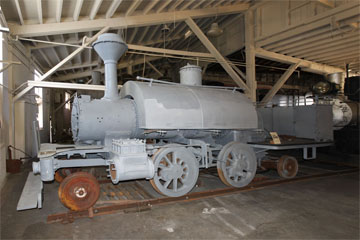
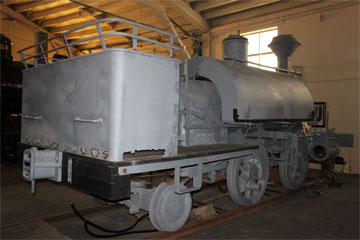
#2 was in the midst of cosmetic restoration when I visited. This 2-4-2T (Tank) locomotive was built by the Baldwin Locomotive Works in Philadelphia, PA, in 1893 for the Bear Harbor Lumber Co., in Moody, CA, but worked only a short time on the line until the railroad shut down in late 1905.
The locomotive later transferred to the Southern Humboldt Lumber Co. Stored outside for many years, it was donated to THA in derelict condition in 1979 by heirs of the Bear Harbor Lumber owners.


